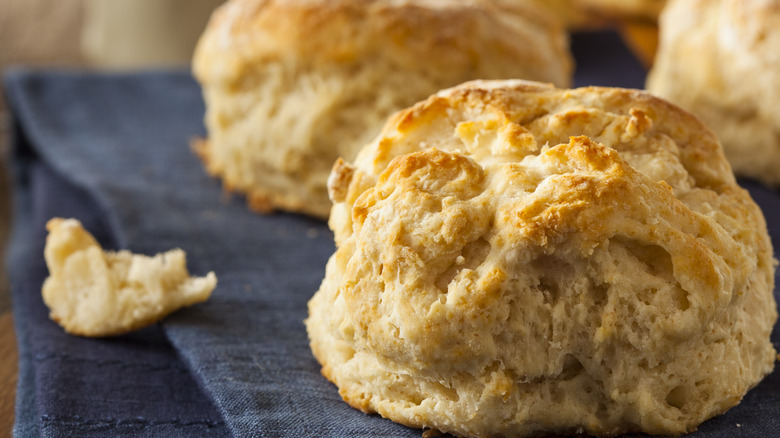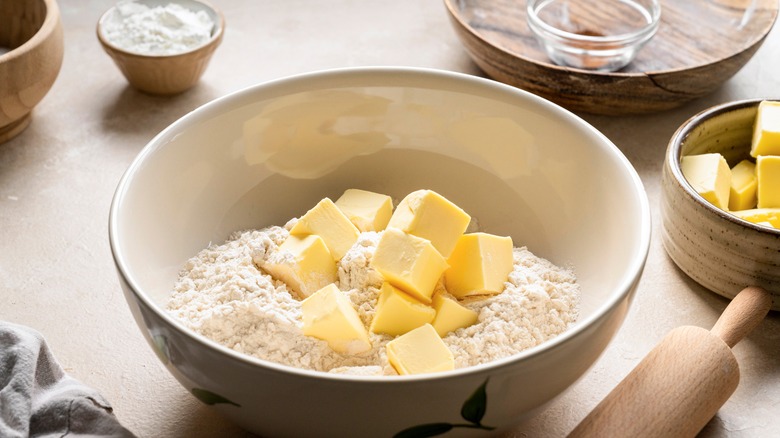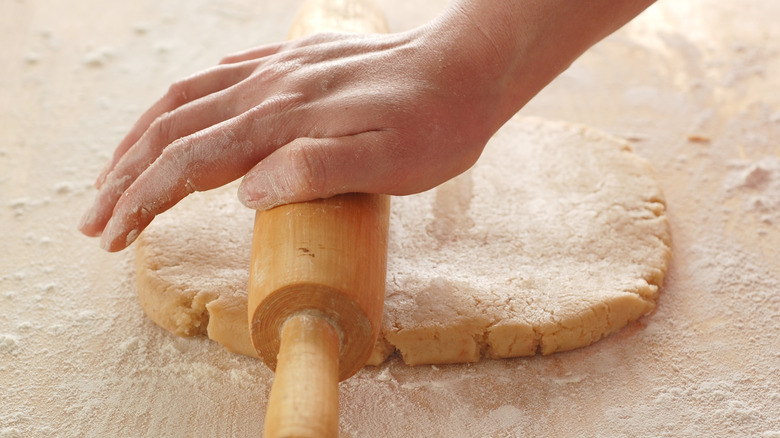Why You Should Only Reroll Biscuit Dough Once
Buttery, flaky, warm, comforting biscuits. Most likely all of us can conjure up a memory of the best biscuit we ever tasted, where we ate it, and why exactly it made us so happy. Maybe it was slathered in southern gravy, spread with homemade preserves, or coated with a crispy cheddar topping. However people like to eat their biscuits, one thing that almost irrefutably makes them so delectable is the welcome presence of those flaky, tender layers.
However, biscuits weren't always the delicate, fluffy pillows we think of today. In fact, the term biscuit still means different things across the world. English Heritage explains that the long history of the biscuit begins potentially as early as Neolithic times. Now, in the U.K., a biscuit is what Americans would probably consider a cookie — or snack cake like a petit-four — and relies on sugar as a main ingredient. By contrast, the light and fluffy biscuit that many in the States know and love today is an invention of the 19th century, brought about by Southern baking when fat, leavening, and air were introduced to the hard traditional biscuit of Europe (via How Stuff Works).
But additional ingredients aren't the only things that separate the flaky from the flat. To recreate this exquisite invention perfectly, you have to use a careful technique.
Handle biscuit ingredients carefully
Successfully baking a biscuit that practically invites you to take a nap on its fluffy surface comes from a unique combination of temperature, physics, quality ingredients, and time. To overstate a common phrase: Baking is a science.
So, where is the magic in that flaky Southern biscuit? It comes from gentle handling, all the way from mixing to rolling to cutting. Even before you get to handling the dough itself, though, it's essential to start with chilly ingredients, says Ina Garten (via Food Network). She explains that when the heat from baking reaches the cold butter, the resulting steam creates those sought-after, puffy air pockets. Some chefs and home cooks keep butter, shortening, and other fat and fat substitutes in the freezer if they intend to use them for baking, which delays any melting that could occur during handling.
After gently combining those ingredients according to the recipe, things can get a little dangerous. Put simply, biscuits are like babies — handle with care. Every little movement, from stirring to transferring the dough, can affect the ingredients' tenderness or start melting them too soon. Even how many times the ingredients are mixed can change the outcome: For example, Southern Living's Test Kitchen suggests stirring 15 times — no more, no less.
Reroll dough once
So, once the ingredients are all combined, how many times should biscuit dough be rolled out? Here comes the science! According to Taste of Home, the answer is twice in total. As their Test Kitchen bakers explain, if you keep playing with the dough, it not only melts the butter before it has the chance to release its puff-perfecting steam in the oven, but it also develops the gluten — potentially leaving you with a rigid, rubbery texture instead of the treat you were looking forward to.
While not all bakers agree with re-rolling the dough only once, just about everyone agrees on minimal handling. And if two times is what prevents the dough from getting tough, then you should probably stick to it. This is the case with many baked goods, from pie crust to pastry to pancakes.
But even though you're just re-rolling once, there's another sneaky step to get crave-able layers: Fold the dough in between rolling. In an interview with Garden and Gun, recipe developer Erika Council says she "folds her dough like an envelope" to make those luscious layers happen. Just be wary! Too much handling can cause melting, premature breakdown of ingredients, and even an entirely different scientific composition altogether. So don't skip the rolling and folding — but approach it with caution.


